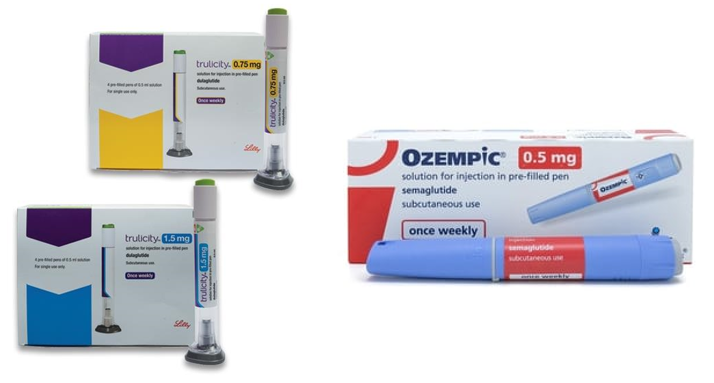
Trulicity (dulaglutide) and Ozempic (semaglutide) are both medications used to treat type 2 diabetes, and they belong to the same class of drugs known as glucagon-like peptide-1 receptor agonists (GLP-1 RAs). While they have some similarities, there are also important differences in their mechanisms of action and side effect profiles.
Mechanism of Action
Trulicity (Dulaglutide): Trulicity is a once-weekly GLP-1 RA. It works by mimicking the action of a natural hormone called glucagon-like peptide-1 (GLP-1). When taken, Trulicity stimulates the GLP-1 receptors in the body, which leads to increased insulin secretion, reduced glucagon secretion (which lowers blood sugar levels), slowed gastric emptying, and increased feelings of fullness. These actions collectively help lower blood sugar levels in people with type 2 diabetes.
Ozempic (Semaglutide): Ozempic is also a GLP-1 RA but is available in a once-weekly injectable form. Like Trulicity, it works by activating the GLP-1 receptors to increase insulin secretion, decrease glucagon production, slow stomach emptying, and promote satiety. The primary active ingredient in Ozempic is semaglutide.
Dosing Frequency
Trulicity is taken once weekly.
Ozempic is also taken once weekly.
Side Effect Profile
Both Trulicity and Ozempic have similar side effects because they belong to the same class of medications. However, individual responses can vary. Common side effects for both medications can include:
– Gastrointestinal Symptoms: Nausea, vomiting, diarrhea, and stomach discomfort are relatively common side effects when starting GLP-1
RAs. These side effects often improve over time.
– Hypoglycemia: GLP-1 RAs like Trulicity and Ozempic can lower blood sugar levels. While the risk of severe hypoglycemia is low when used as
monotherapy, the risk may increase when combined with other diabetes medications that can cause hypoglycemia.
– Weight Loss: Many people experience weight loss with GLP-1 RAs due to their effect on appetite and slowing of gastric emptying.
– Injection Site Reactions: Some individuals may experience mild irritation or redness at the injection site.
– Pancreatitis: Although rare, both Trulicity and Ozempic carry a warning about the risk of pancreatitis, a potentially serious inflammation of
the pancreas.
Dosage Strengths
Trulicity is available in several dosage strengths, including 0.75 mg and 1.5 mg
Ozempic is typically available in a 0.25 mg, 0.5 mg, and 1.0 mg dosage strength.
Clinical Trials and Studies
Both medications have been studied in clinical trials and have demonstrated their effectiveness in improving glycemic control, reducing HbA1c levels, and promoting weight loss in people with type 2 diabetes.
Formulation
Trulicity is available as a prefilled, single-use pen for subcutaneous injection.
Ozempic is also available as a prefilled, single-use pen for subcutaneous injection.
Manufacturers
Trulicity is manufactured by Eli Lilly and Company.
Ozempic is manufactured by Novo Nordisk.
Indications
Both Trulicity and Ozempic are indicated for use in adults with type 2 diabetes to improve glycemic control.
Additional Uses
Trulicity is also approved for reducing the risk of major cardiovascular events in adults with type 2 diabetes who have established cardiovascular disease.
Ozempic has an additional indication for reducing the risk of major adverse cardiovascular events in adults with type 2 diabetes and established cardiovascular disease.
